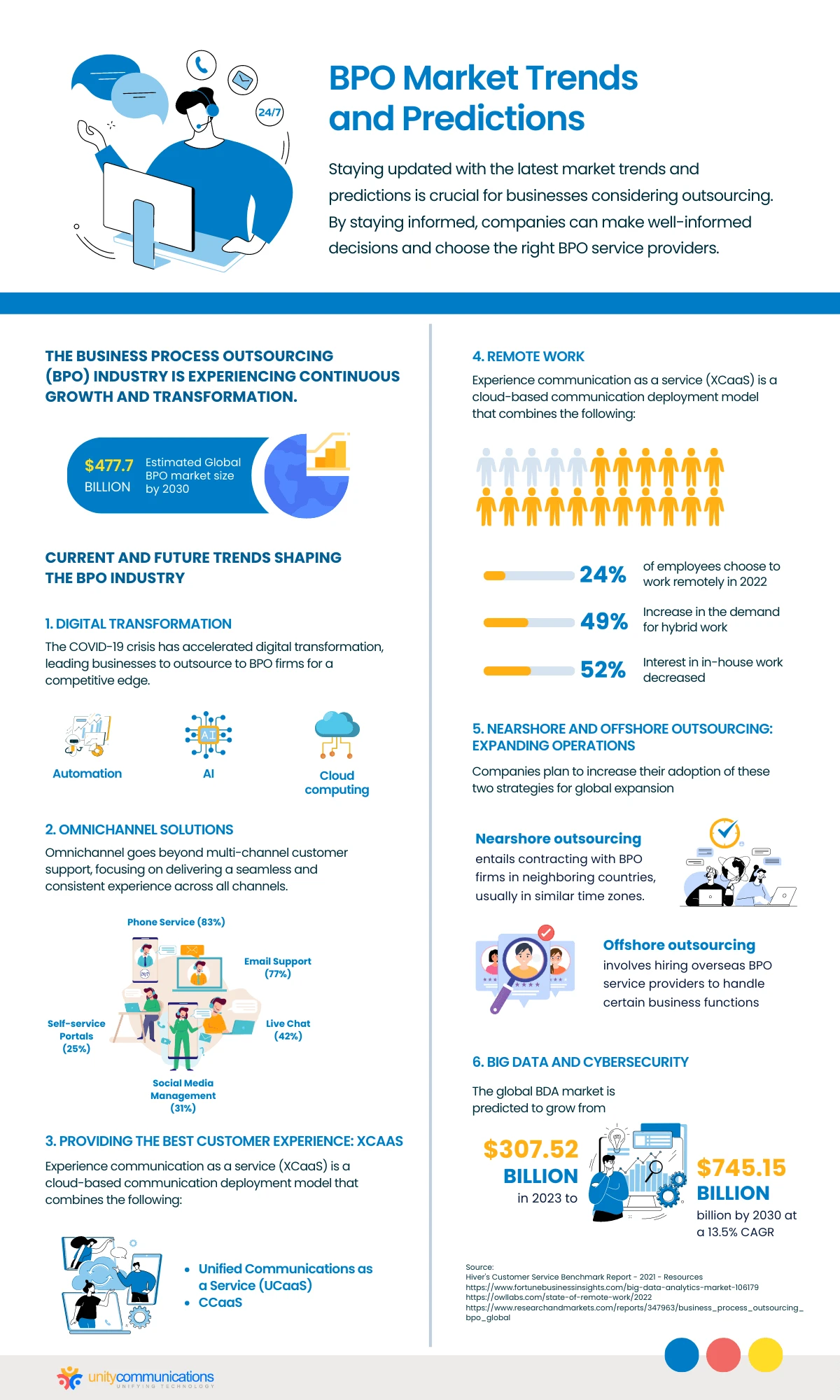Table of Contents
Global business process outsourcing (BPO) has become a viable solution for achieving growth and success. But to maximize the strategy’s full potential, companies should keep up with the latest trends in the industry. That is one way to stay ahead of the curve in a fast-paced business landscape.
Wondering what the current and future trends in the outsourcing industry are?
This page shares the top BPO trends and predictions to help you make informed outsourcing decisions. Read below.
BPO Overview: Its Significance and Market Changes

Let us begin by asking: What is BPO? BPO involves subcontracting non-core business processes to a third-party service provider instead of handling them in-house.
Companies of all sizes have various reasons for employing outsourcing. BPO for small businesses and startups allows farming out of secondary activities to service providers so that these businesses can focus on their core competencies. Big companies also outsource certain functions to reduce labor and operating costs.
Over the years, BPO has experienced significant market changes. What started as a business strategy in the manufacturing sector has expanded to cover almost all industries, from e-commerce to healthcare. In addition to handling front-office (customer-facing) functions, BPO firms now offer back-end operations. Even call centers have transitioned to contact centers.
Learn about the factors influencing the BPO industry below.
Key Factors Driving BPO Market Changes
Technology, consumer expectations, and evolving business requirements heavily influence the landscape of BPO trends and forecasts. Let’s delve into the driving factors that are instigating changes within the BPO market:
- Advancing technology. Technology has emerged as a transformative force in the business realm. Deloitte highlights key digital catalysts, including automation, single-instance enterprise resource planning (ERP) systems, case service management, and cloud computing. The advent of artificial intelligence (AI) also holds immense potential, albeit amid recent controversies.
- Evolving consumer demands. Today’s customers harbor higher expectations than ever, as affirmed by 93% of service teams surveyed by Hubspot. The proliferation of the internet and social media has endowed consumers with greater knowledge and empowerment. Consequently, they seek personalized, on-demand services and an exceptional customer experience.
- Tight market competition. The BPO landscape has become fiercely competitive, with providers offering various outsourcing services. Depending on your specific requirements, established leaders and emerging contenders can deliver substantial value. For businesses exploring outsourcing options, this increases the likelihood of finding a BPO partner that aligns with their niche, size, budget, and needs.
- Changing business landscape. The business environment undergoes continual transformations due to various factors, including global events. The COVID-19 pandemic serves as a pertinent example. This crisis catalyzed the widespread adoption of remote work, further accelerating the pace of digitalization.
6 BPO Market Trends and Predictions

The BPO industry has been constantly evolving and expanding. The global BPO market size can grow from $292.3 billion in 2022 to $477.7 billion by 2030 at an expected compound annual growth rate (CAGR) of 6.3% during the forecast period.
Businesses looking to outsource should stay updated with the latest market trends and predictions. That allows them to make informed outsourcing decisions and partner with the right BPO service providers.
Let us explore the current and future trends of the BPO market below.
1. Digital Transformation: Harnessing the Power of Technology
Digital transformation is one of the BPO trends and predictions triggered by the pandemic. According to McKinsey, the COVID-19 crisis accelerated this shift in business. Many companies have adopted the latest digital tools and technologies to gain a competitive advantage. Some businesses outsource to BPO firms to leverage the following:
- Automation. Robotic process automation (RPA) is a game-changer for the BPO industry. This technology automates various tasks, helping reduce manual work and accelerate business processes.
- AI. This technology simulates intelligence in machines, allowing them to work like humans. A chatbot is a perfect example of AI for customer service; it assists customers with simple inquiries.
- Cloud Computing. This application delivers services by accessing software, databases, servers, and networks via the Internet. BPO companies use contact center as a service (CCaaS) technology for their customer service operations to enhance the buyer’s experience.
2. Omnichannel Solutions: Enhancing Customer Interactions
Omnichannel is more than just providing customer support via multiple channels. It is about offering them a seamless and consistent experience across all channels. It is one of the BPO trends and predictions most BPO firms adopt.
According to Hiver’s 2021 report, 60% of service teams provide customer support via three or more communication channels. Many businesses hire BPO providers to offer this capability. Below are the percentages of respondents using different channels:
- Phone service (83%). The phone is still the most preferred channel for communication. BPO firms use computer telephony integration (CTI) for their call centers, handling customer service, sales, and tech support.
- Email support (77%). Email remains useful for business and marketing. Aside from phone services, BPO companies offer email and chat support to assist their customers.
- Live chat (42%). Due to speed and convenience, real-time chat has become increasingly popular for customer service. BPO providers employ and train agents to respond to customers via online chat platforms.
- Social media management (31%). Social media has become essential for business as people live and breathe on Facebook, Instagram, Twitter, YouTube, and TikTok. BPO firms leverage these channels to interact with customers and support them.
- Self-service portals (25%). Self-service portals provide resources and allow customers to solve problems independently. Examples of these used in the BPO industry are interactive voice response (IVR), AI-powered chatbots, and knowledge base centers.
3. XCaaS: Providing the Best Customer Experience
Experience communication as a service (XCaaS) solutions have gradually penetrated the BPO industry. But for the uninitiated, this software technology is a cloud-based communication deployment model that combines both:
- Unified Communications as a Service (UCaaS). This platform is used mainly for internal communication. Employees access video calls, voice tools, chat applications, cloud-hosted emails, and other collaboration tools to conduct business with each other.
- CCaaS. This software is a cloud-based, provider-hosted technology used for customer interaction. Employees and customers communicate via phone calls, emails, live chat, social media, and even short message services (SMS).
XCaaS is one of the BPO trends and predictions to watch out for. This technology offers a unified platform for employees and customers for seamless communication. It integrates digital transformation and omnichannel solutions to enhance employee-customer interactions.
BPO companies can capitalize on this technology to improve internal and external communication. BPO service providers can seamlessly communicate and collaborate with their clients using this centralized platform. At the same time, their BPO agents can utilize the same platform to assist their clients’ customers.
4. Remote Work: Carving the Future Business Landscape
Because of the pandemic, remote work has become more prevalent in business. Companies across different industries have seen the cost-effective benefits of flexible work arrangements.
According to Owl Labs, the number of employees choosing to work remotely rose by 24% in 2022 compared to 2021. While the demand for hybrid work increased by 16%, interest in in-house work decreased by 24%. Thus, remote work will likely shape our business landscape’s future.
The outsourcing sector is no exception, with remote work considered one of the BPO trends and predictions. Below are some types of work arrangements that apply to the industry:
- Work-from-home (WFH) setup. COVID-19 forced businesses to adopt the WFH setup, and some companies have continued such an arrangement. In the Philippines, for example, the government extended BPO firms’ requests to continue this arrangement without risking their tax incentives.
- Hybrid work setup. The pandemic has also led to the emergence of hybrid work setups. Some BPO companies allow their employees to work from home on most days and go to the office occasionally for important business endeavors.
- Gig economy. The gig economy is a labor market where businesses hire part-time workers, usually independent contractors and freelancers. For their clients, some BPO providers tap into a pool of skilled freelancers, such as virtual assistants and digital marketers.
5. Nearshore and Offshore Outsourcing: Expanding Operations
Nearshore and offshore outsourcing have long helped businesses scale operations and reduce costs. As some BPO trends and predictions suggest, companies plan to increase their adoption of these strategies for global expansion. To learn more about nearshoring vs. offshoring, consider the differences below:
- Nearshore outsourcing entails contracting with BPO firms in neighboring countries, usually in similar time zones. For example, a retail company in the U.S. partners with BPO providers in countries in Latin America for its customer service operations. They hire bilingual agents to assist their American and Spanish customers.
- Offshore outsourcing involves hiring overseas BPO service providers to handle certain business functions. For example, an e-commerce business delegated customer support, data entry, and inventory management to BPO firms in the Philippines.
Top brands and tech giants have long outsourced to expand operations and access new markets. For example, the Coca-Cola Company initially outsourced its manufacturing and now has bottling partners operating worldwide. IBM is another example of a company that has outsourced 75% of its workforce globally to BPO providers.
The advent of globalization paved the way for nearshore and offshore outsourcing. The world has become a global village, and outsourcing has become instrumental.
6. Big Data and Cybersecurity: Leveraging and Protecting Information
The business landscape grapples with an ever-expanding volume of information and a growth trajectory that seems boundless. Within the BPO industry, numerous providers are responsible for collecting, documenting, organizing, and safeguarding their clients’ invaluable data.
In today’s data-centric world, businesses also employ the prowess of big data analytics (BDA) to illuminate the path for business forecasting and informed decision-making. Many BPO providers adeptly leverage BDA to manage their clients’ data effectively. It’s worth noting that the global BDA market is poised for substantial growth, projected to surge from $307.52 billion in 2023 to a staggering $745.15 billion by 2030, exhibiting a robust 13.5% CAGR.
Moreover, the intertwined domains of big data and cybersecurity emerge as a prominent facet among BPO trends and forecasts. Increasingly, businesses seek service providers fortified with cybersecurity solutions. These BPO firms establish stringent network security protocols and uphold data privacy regulations as they shoulder the responsibility of safeguarding their clients’ sensitive information. Their mission is to fortify data against an array of cyber threats, including:
- Password attacks. Cybercriminals pilfer login credentials to illicitly access systems or networks.
- Malware. Malicious software is a favored tool among hackers for unauthorized access or system damage.
- Phishing.Hackers employ deceptive tactics to manipulate vulnerable users into divulging confidential information.
- Distributed Denial of Service (DDoS) attacks. Cyber attackers inundate a website or system with excessive traffic, rendering it inaccessible to legitimate users.
- Man-in-the-middle (MITM) attacks. Hackers intercept communication between two parties, enabling them to siphon off critical data.
The Bottom Line

The outsourcing industry constantly evolves as it adapts and thrives in the digital age. Staying updated with the latest BPO trends and predictions is crucial for making informed outsourcing decisions. As such, consider the following trends:
- Digital transformation
- Omnichannel solutions
- XCaaS
- Remote work
- Big data and cybersecurity
- Nearshore and offshore outsourcing
Studying these industry trends helps you make the right decisions and stay ahead of the curve. Keeping abreast of predictions ensures your business is poised to achieve scalability, sustainability, and success.
Looking for a BPO partner aligned with current and future trends? Contact us, and let’s connect! Unity Communications offers various outsourcing services to businesses of all sizes across different industries. We will scale your business based on the latest BPO trends!




